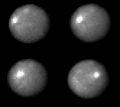Fichièr:Ceres Rotation.jpg

Talha d'aquesta previsualizacion: 676 × 600 pixèls. Autras resolucions : 270 × 240 pixèls | 541 × 480 pixèls | 880 × 781 pixèls.
Fichièr d'origina (880 × 781 pixèl, talha del fichièr: 94 Ko, tipe MIME: image/jpeg)
Istoric del fichièr
Clicar sus una data e una ora per veire lo fichièr tal coma èra a aqueste moment
| Data e ora | Miniatura | Dimensions | Utilizaire | Comentari | |
|---|---|---|---|---|---|
| actual | 30 genièr de 2006 a 07.53 |  | 880×781 (94 Ko) | Arnomane | higher resolution |
| 9 setembre de 2005 a 13.17 |  | 300×300 (4 Ko) | Vesta~commonswiki | {{Information| |Description = NASA's Hubble Space Telescope took these images of the asteroid 1 Ceres over a 2-hour and 20-minute span, the time it takes the Texas-sized object to complete one quarter of a rotation. One day on Ceres lasts 9 hours. The bri |
Paginas que contenon lo fichièr
La pagina çaijós compòrta aqueste imatge :
Usatge global del fichièr
Los autres wikis seguents utilizan aqueste imatge :
- Utilizacion sus ba.wikipedia.org
- Utilizacion sus be-tarask.wikipedia.org
- Utilizacion sus bs.wikipedia.org
- Utilizacion sus ca.wikipedia.org
- Utilizacion sus ca.wikinews.org
- Utilizacion sus cs.wikipedia.org
- Utilizacion sus el.wikipedia.org
- Utilizacion sus eo.wikipedia.org
- Utilizacion sus es.wikinews.org
- Utilizacion sus fa.wikipedia.org
- Utilizacion sus fr.wikipedia.org
- Utilizacion sus hu.wikipedia.org
- Utilizacion sus hy.wikipedia.org
- Utilizacion sus id.wikipedia.org
- Utilizacion sus it.wikipedia.org
- Utilizacion sus ja.wikipedia.org
- Utilizacion sus ka.wikipedia.org
- Utilizacion sus ko.wikipedia.org
- Utilizacion sus mk.wikipedia.org
- Utilizacion sus mwl.wikipedia.org
- Utilizacion sus nl.wikipedia.org
- Utilizacion sus no.wikipedia.org
- Utilizacion sus ru.wikipedia.org
- Utilizacion sus sk.wikipedia.org
- Utilizacion sus te.wikipedia.org
- Utilizacion sus tl.wikipedia.org
- Utilizacion sus zh.wikipedia.org

